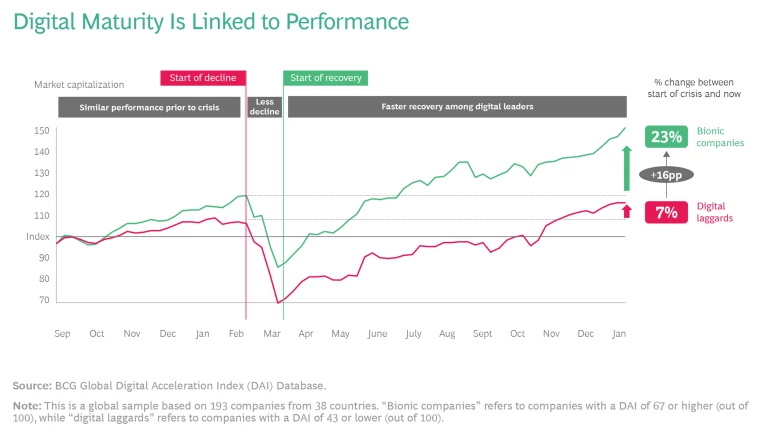Google has turned 23. Amazon is 27; Facebook, 17. Apple has produced 12 generations of the iPhone since 2007. How do digital natives grow from nothing to become the world’s most valuable companies at such young ages while the largest legacy firms place massive bets on digital transformation and make only incremental progress? The question gains urgency as the pandemic pushes consumers and businesses toward more-digital engagement and business models.
The answer lies in the differing ways companies apply systems thinking—the concept is a norm for digital natives but mostly alien to legacy companies.
Systems Thinking in Digital Versus Legacy Companies
Digital natives work very differently from legacy companies: they embed technology and data science into their organizations and processes from the day they are founded. So, all of the organization’s systems function together easily. Digital natives grow up in a way that creates a coherent “digital + human,” or bionic, operating model.
Legacy companies didn’t start out with digital genes. They built themselves, for decades, on human-centric processes and teams known to drive business outcomes. Today, legacy companies, seeking to emulate the rapid success of digital natives, tend to copy or import what they consider to be the core success drivers, piece by piece. They rebuild the tech stack, for example, or assemble a data science team to introduce AI capabilities. But they fail to apply systems thinking to the digital transformation process. Addressing one element of the bionic operating model while others go largely unattended is akin to putting a new engine in an old car: the revitalized vehicle might go fast for a mile or two, but soon the transmission fails or a rusted axle cracks. In fact, multiple components of the entire vehicle need to be overhauled—and redesigned to work together—to achieve a new level of speed and handling.
It’s a lot easier to renovate an old car than it is to redesign a global enterprise. Management teams that want to harness the power of digital capabilities need to think systematically about becoming bionic organizations—marrying the power of humans and machines to achieve superior performance throughout the organization and operating model.
How to Think Systematically
Many elements of bionic companies, such as agile teams and cloud-based technologies, are well known. But the formula for putting the elements together is neither immediately evident nor easily implemented. Once companies have a good understanding of the long (but manageable) list of elements required for systems thinking, though, rapid progress and value creation are possible.
First, all key business processes need to be redesigned, blending technological and human capabilities to radically improve business outcomes. Becoming a bionic company isn’t a goal in and of itself—it’s a means to radical performance improvement.
Becoming a bionic company isn’t a goal in and of itself—it’s a means to radical performance improvement.
To build these bionic processes, companies must organize into new types of teams that build and manage the new technology that powers the processes. Staffing these teams requires new talent: data scientists and engineers, of course, but also product managers and experts on human-centric design.
To build and manage technology most effectively, ways of working must fundamentally change. Agile team processes drive increased adaptiveness and speed of execution. Redesigned organization structures replace the vertical business silos that worked well to manage human teams; instead, bionic companies use horizontal platform structures, which are better suited to the investment requirements of technology and data science.
The core technology stack must evolve—radically. To enable rapid product development, the organization has to move beyond infrastructure- and transaction-oriented technology (such as ERP) and invest more money and resources in data and smart-product technology layers. To avoid the endless delays and high costs imposed by legacy tech models, the tech stack must be rebuilt to match the modern, modular architecture common to agile organizations.
Even corporate strategy, advantage, and purpose must evolve. New sources of competitive advantage are often based on data or a company’s position within a broader ecosystem.
To build and manage this new type of organization requires a new leadership model.
To build and manage this new type of organization requires a new leadership model. The heads of legacy companies must master leading new types of talent, operating in an agile manner, and ensuring that their organizations build technology to drive outstanding results. Their job increasingly becomes designing and enabling the organization rather than managing it.
The Bionic Model Pays Off
While the challenge of transforming is hard, the benefits are enormous. Our most recent research shows that the bionic companies on BCG’s Digital Acceleration Index (companies that score 67 or higher on a scale of 100 across 36 digital dimensions) increase EBITDA annually at almost twice the rate of digital laggards (companies that score 43 or lower), while their enterprise value rises more than twice as much each year. These digitally enabled companies have outperformed peers before, during, and coming out of the COVID-19 crisis. (See the exhibit.)
Legacy businesses that integrate people and machines are starting to show some eye-popping results.
Legacy businesses that integrate people and machines are starting to show some eye-popping results.
One fashion retailer used AI to improve its ordering efficiency for the next season by 25%. When it combined its AI algorithms with human insights into real-time fashion trends, ordering efficiency jumped by 50%.
Insurance companies using bionic approaches have boosted customer satisfaction to 70%, compared with 48% for digital laggards, while reducing their expense ratios by an average of 5 percentage points, compared with 1 percentage point for laggards.
Digital success cannot be achieved with any single digital initiative. Indeed, the lack of one or more key ingredients (such as the right talent, tech stack, or organization structure) will fundamentally erode the return on all digital investments. Developing and sequencing the digital change agenda takes time, vision, smart investment, and persistence in implementation. It’s worth remembering that as young as they are, the digital stars did not achieve their current positions overnight. It took years of hard work. The focus of the work is what counts.






